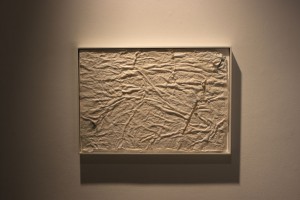Text means tissue; but whereas hitherto we have always taken tissue as a product, a ready-made veil, behind which lie, more or less hidden, meaning (truth), we are now emphasizing, in the tissue, the generative idea that the text is made, is worked out in a perpetual interweaving; lost in this tissue—this texture—the subject unmakes himself, like a spider dissolving in the constructive secretions of its web.[1]
And thus the seeming unweaving and interweaving of an idea that began with the sensation of sand ripples under foot. Yet it goes back further to the problem of imaging a response to an experience, or a continually evolving series of experiences. How to image the sensory representation of touch? But not simply touch as a tactile sensation, but the notion that a surface, a space, an environment holds a range of visceral qualities that are indexed to the body through representation. What we take for granted as ‘touch’, is in fact a series of codes based on knowledge and previous actions that inform this so called ‘feeling’. I can imagine my fingers tracing over the sand, the sand clinging to the tips of my fingers as I drag shallow excavations through its damp mild resistance. I know the feeling of this movement, of the coldness, the grains separating, the grit under my nails; I can conjure this representation very clearly. And so it is to walk over the deep sand ripples and feel the undulations and slight indentation under foot.
This text is not a given and I attempt to weave it into something else, rather than a seemingly indexed representation (a photograph). This text existed before my enunciation of it (to all those who have walked over sand flats); it will continue to be woven by anyone who transposes the senses into an idea. I am interested in the release of the text through a series actions that are relatively unscripted and not over determined; the possibility of a ‘perpetual interweaving’ where my body is absorbed into the materiality of representation.
Upon return to the initial thread, it was the notion that the idea of a place could be affective while simultaneously transgress any need for indexation; the signifiers released by the representations of action can find their own way. It can be thought of as a provocation for something to happen, based on a particular sensory representation. This provocation, this will to act, this need to signify the body in its absence, its loss, lies at the center of this web of radiating textures; this text has no end.
The ripples in the sand of the receded tide became a departure point, a node on the intertextual web. The idea of making a paper cast of the ripples in the sand of the receded tide seemed plausible; an action of layering tissue paper on the sand ripples bonded together with diluted PVA.
The tissue paper casting did not dry in the wet sand before the tide came; it almost washed the work away. The form of the ripples collapsed once dragged onto a supporting structure. It reverted to a pile of bonded tissue paper, with tares that occurred when dragged onto the board still wet.
The tissue, the text that emerged has produced a series of further provocations that continue to be made, and multiply. The incessant interweaving of texts belies an intention to allow the body to reconfigure its absence.
Flag, tissue paper, wax, wood, 2009
[1] Roland Barthes, The Pleasure of the Text, 1st American ed. (New York: Hill and Wang, 1975), 64.

